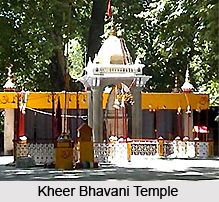 The Kheer Bhavani Temple is situated in Tullamula in Srinagar district. Steams and Chinar trees surround the place, where the temple stands. A revered Hindu shrine, the temple is committed to Ragnya Devi, a Hindu manifestation of Goddess Durga. Representing the goddess is a sacred hexagonal spring at Tullamula village, which houses a small marble temple. The temple is special, not for the reason of its architecture, but for the unusual tradition of offering `kheer` to the presiding deity.
The Kheer Bhavani Temple is situated in Tullamula in Srinagar district. Steams and Chinar trees surround the place, where the temple stands. A revered Hindu shrine, the temple is committed to Ragnya Devi, a Hindu manifestation of Goddess Durga. Representing the goddess is a sacred hexagonal spring at Tullamula village, which houses a small marble temple. The temple is special, not for the reason of its architecture, but for the unusual tradition of offering `kheer` to the presiding deity.
According to legends, Lord Ram worshipped Goddess Ragnya, during the period of his exile. When the exile was finally terminated, Rama asked Hanuman to relocate the shrine of the Goddess to Shadipora. Another legend speaks of Ragnya Devi appearing in the dream of a priest named Raghunath Gadroo and asked him to shift her shrine to the present place. Subsequently, the shrine was shifted in the village of Tullamulla. The original temple was constructed by Maharana Pratap Singh in 1912, which was later refurbished by Maharaj Hari Singh. Inside the temple complex, an image of Ragnya Devi is placed, made of white marble.
The Goddess of the Kheer Bhavani Temple is depicted in the form of a natural hexagonal spring, highly admired by the devotees. The temple attains reputation due the pilgrims` offering `kheer` (a sweet dish made of milk) as `prasad` (holy giving to the almighty). It is alleged that kheer turns black in color, portending about the imminent disaster. An annual festival is celebrated at the Kheer Bhavani temple on the occasion of the Shukla Paksha Ashtami. On this particular day, devotees observe fasting to gather at the temple complex to pay their homage to the Goddess. Likewise, Jesht Ashtami (May-June) is another occasion when people come from far and near to catch a glimpse of the Mother. People are of the belief that on this day, the spring changes its color with blessings of the Goddess. The festival is concluded with `Maha Yagna` to please Ragnya Devi.











